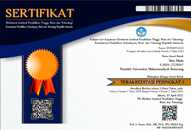Pemberian Posisi Pronasi Meningkatkan Saturasi Oksigen pasien Covid-19 dengan High Flow Nasal Canul Oxygen Non Invasive Ventilator Support
(1) Universitas Muhammadiyah Semarang
(2) Universitas Muhammadiyah Semarang
(3) Universitas Muhammadiyah Semarang
(*) Corresponding Author
Abstract
Virus Covid-19 berdampak pada pemberatan gangguan sistem pernafasan yang menyebabkan angka kematian tinggi yaitu acute respiratory distress syndrome (ARDS) sehingga pertukaran gas menjadi buruk. Posisi pronasi adalah posisi tengkurap yang dimaksudkan untuk meningkatkan ventilasi sehingga pertukaran gas akan lebih baik pada pasien yang terpasang non invasive ventilator. Tujuan studi kasus ini adalah untuk mengaplikasikan evidenced based practice nursing dalam tatalaksana gangguan pertukaran gas menggunakan posisi pronasi. Metode studi kasus dengan pendekatan asuhan keperawatan terhadap 2 pasien Covid-19 dengan acute respiratory distress syndrome yang terpasang high flow nasal canula dan saturasi oksigen dibawah 96%. Intervensi dengan memberikan posisi pronasi selama 1 jam dan diukur saturasi oksigennya menggunakan oksimeter yang sudah terkalibrasi. Pemberian intervensi dilakukan selama 3 hari. Hasil studi menunjukkan ada peningkatan saturasi oksigen pada pasien dengan rata-rata peningkatan 3,5%. Posisi pronasi efektif meningkatkan saturasi oksigen pasien covid-19.
Keywords
Full Text:
PDFReferences
Anand, S., Baishya, M., Singh, A., & Khanna, P. (2020). Effect of awake prone positioning in COVID-19 patients- A systematic review. Trends in Anaesthesia and Critical Care, November. https://doi.org/10.1016/j.tacc.2020.09.008
Arofah, R. N., & Sudaryanto, A. (2020). Literature Review Penggunaan High Flow Nasal Cannula (Hfnc) Pada Pasien Gagal Nafas Akut Di Unit Gawat Darurat. Literature Review, November, 33–37.
Burhan, E., Susanto, A. D., Nasution, S. A., Ginanjar, Ceva, E., Pitoyo, W., Susilo, A., Firdaus, I., Santoso, A., Arifa, D., Juzar, Arif, S. K., Wulung, N. G. . L., Adityaningsih, D., Syam, A. F., Rasmin, M., Rengganis, I., Sukrisman, L., Damayanti, T., … Harsini. (2020). Buku Pegangan Pencegahan dan Penatalaksanaan COVID-19. 68. pdf-intl.alicdn.com
Caputo ND, Strayer RJ, L. R. (2020). Early self-proning in awake, non-intubated patients in the emergency department: a single ED’s experience during the COVID-19 pandemic.
Damarla, M., Zaeh, S., Niedermeyer, S., Merck, S., Niranjan-Azadi, A., Broderick, B., & Punjabi, N. (2020). Prone positioning of nonintubated patients with COVID-19. American Journal of Respiratory and Critical Care Medicine, 202(4), 604–606. https://doi.org/10.1164/rccm.202004-1331LE
Elharrar X, Trigui Y, D. A.-M. (2020). Use of prone positioning in nonintubated patients with COVID-19 and hypoxemic acute respiratory failure.
Gedikloglu, M., Gulen, M., Satar, S., I., Y. K., Avci, A., Yesiloglu, O., K., & O. (2019). How to treat patients with acute respiratory failure? Conventional oxygen therapy versus high-flow nasal cannula in the emergency department.
Ghelichkhani, P., & Esmaeili, M. (2020). Prone Position in Management of COVID-19 Patients; a Commentary. Archives of Academic Emergency Medicine, 8(1), 1–3. https://doi.org/10.22037/aaem.v8i1.674
Marjanovic, N., Guénézan, J., Frat, J. P., & Mimoz, O., Thille, A. W. (2020). High-flow nasal cannula oxygen therapy in acute respiratory failure at Emergency Departments: A systematic review.
Mercat, A. F. J. P. T. A. W., & Robert, R. G. C. R. S. P. S. (2015). High-flow oxygen through nasal cannula in acute hypoxemic respiratory failure. Journal of Medicine.
Paul, V., Patel, S., Royse, M., Odish, M., Malhotra, A., & Koenig, S. (2020). Proning in Non-Intubated (PINI) in Times of COVID-19: Case Series and a Review. Journal of Intensive Care Medicine, 35(8), 818–824. https://doi.org/10.1177/0885066620934801
Potter, & Perry. (2009). Fundamental of nursing (7th ed.). Salemba Medika.
Rahmani, F., Salmasi, S., & Rezaeifar, P. (2020). Prone Position Effects in the Treatment of Covid-19 Patients. Caspian Journal of Internal Medicine, 11(Suppl 1), 580–582. https://doi.org/10.22088/cjim.11.0.580
Sartini C, Tresoldi M, S. P. (2020). Respiratory parameters in patients with COVID-19 after using noninvasive ventilation in the prone position outside the intensive care unit.
Schifino, G., de Grauw, A. J., Daniele, F., Comellini, V., Fasano, L., & Pisani, L. (2020). Effects of prone and lateral position in non-intubated patients with 2019 Novel Coronavirus (COVID-19) pneumonia. Pulmonology, 27. https://doi.org/10.1016/j.pulmoe.2020.10.015
Solverson K, Weatherald J, P. K. (2020). Tolerability and safety of awake prone positioning COVID-19 patients with severe hypoxemic respiratory failure.
Tim Pokja SDKI DPP PPNI. (2016). Standar Diagnosis Keperawatan Indonesia (1st ed.). PPNI.
Tim Pokja SDKI DPP PPNI. (2018a). Standar Intervensi Keperawatan Indonesia (1st ed.). PPNI.
Tim Pokja SDKI DPP PPNI. (2018b). Standar Luaran Keperawatan Indonesia (SLKI) (1st ed.). PPNI.
Venus, K., Munshi, L., & Fralick, M. (2020). Prone positioning for patients with hypoxic respiratory failure related to COVID-19. Cmaj, 192(47), E1532–E1537. https://doi.org/10.1503/cmaj.201201
Zang, X., Wang, Q., Zhou, H., Liu, S., Xue, X., Zhang, W., Gao, Q., Xie, J., Jiang, C., Ding, X., Zhang, J., Lu, F., Chen, W., Zhen, J., He, P., Zhu, M., Zhang, X., Yuan, X., Tian, R., … Xue, Z. (2020). Efficacy of early prone position for COVID-19 patients with severe hypoxia: a single-center prospective cohort study. Intensive Care Medicine, 46(10), 1927–1929. https://doi.org/10.1007/s00134-020-06182-4
Article Metrics
Abstract view : 737 timesPDF - 78 times
DOI: https://doi.org/10.26714/nm.v4i1.8159
Refbacks
- There are currently no refbacks.
Copyright (c) 2023 Ika Fahmawati, Edy Soesanto, Yunie Armiyati

This work is licensed under a Creative Commons Attribution 4.0 International License.
Jl. Kedungmundu Raya No. 18 Semarang Gedung NRC University of Muhammadiyah Semarang
Phone: 02476740287
Fax: 02476740287
Email: [email protected]






